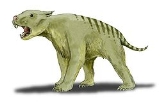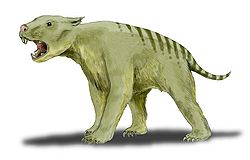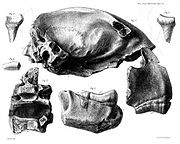
Marsupial lion
Encyclopedia
Thylacoleo is an extinct genus
of carnivorous marsupial
s that lived in Australia
from the late Pliocene
to the late Pleistocene
(2 million to 46 thousand years ago). Some of these "marsupial lions" were the largest mammal
ian predators in Australia of that time, with Thylacoleo carnifex approaching the weight of a small lion
.
 Pound for pound, Thylacoleo carnifex had the strongest bite of any mammal
Pound for pound, Thylacoleo carnifex had the strongest bite of any mammal
species living or extinct; a 100 kg (220.5 lb) T. carnifex had a bite comparable to that of a 250 kg (551.2 lb) African Lion
and is thought to have hunted large animals such as Diprotodon
spp. and giant kangaroo
s. It also had extremely strong forelimbs, with retractable catlike claws, a trait previously unseen in marsupials. Thylacoleo also possessed enormous hooded claws set on large semi-opposable thumbs, which were used to capture and disembowel prey. The long muscular tail was similar to that of a kangaroo. Specialized tail bones called chevrons
allowed the animal to tripod itself, and freed the front legs for slashing and grasping.
Its strong forelimbs, retracting claws and incredibly powerful jaws mean that it may have been possible for Thylacoleo to climb trees and perhaps to carry carcasses to keep the kill for itself (similar to the leopard
today). Due to its unique predatory morphology, scientists repeatedly claim Thylacoleo to be the most specialized mammalian carnivore of all time.
Thylacoleo was 71 cm (28 in) at the shoulder and about 114 cm (44.9 in) long from head to tail. The T. carnifex species is the largest, and skulls indicate they averaged 101 kilogram, and individuals reaching 124 kilogram were common.
 Thylacoleo was first described by Sir Richard Owen
Thylacoleo was first described by Sir Richard Owen
in 1859.
In 2002, eight remarkably complete skeleton of T. carnifex were discovered in a limestone cave under Nullarbor Plain
, where the animals fell through a narrow opening in the plain above. Based on the placement of their skeletons, at least some survived the fall, only to die of thirst and starvation.
(Marsupial lion
s)
Marsupial "lion" alludes to the superficial resemblance to the placental lion and its ecological niche as a large predator. Thylacoleo is not related to the modern lion Panthera leo
.
Genus: Thylacoleo (Thylacopardus) - Australia's marsupial lions, that lived from about 2 million years ago, during the late Pliocene and became extinct about 30,000 years ago, during the late Pleistocene epoch.
T. crassidentatus fossils have been found in southeastern Queensland
.
The holotype fossil was found in Town Cave in South Australia. Additional, possible specimens have been found at the Bow fossil site by students and staff of the University of New South Wales in 1979.
The family it belonged to, the Thylacoleonidae, has fossil representatives (e.g. Priscileo
and Wakaleo
) dating back to the late Oligocene, some 24 million years.
Genus
In biology, a genus is a low-level taxonomic rank used in the biological classification of living and fossil organisms, which is an example of definition by genus and differentia...
of carnivorous marsupial
Marsupial
Marsupials are an infraclass of mammals, characterized by giving birth to relatively undeveloped young. Close to 70% of the 334 extant species occur in Australia, New Guinea, and nearby islands, with the remaining 100 found in the Americas, primarily in South America, but with thirteen in Central...
s that lived in Australia
Australia
Australia , officially the Commonwealth of Australia, is a country in the Southern Hemisphere comprising the mainland of the Australian continent, the island of Tasmania, and numerous smaller islands in the Indian and Pacific Oceans. It is the world's sixth-largest country by total area...
from the late Pliocene
Pliocene
The Pliocene Epoch is the period in the geologic timescale that extends from 5.332 million to 2.588 million years before present. It is the second and youngest epoch of the Neogene Period in the Cenozoic Era. The Pliocene follows the Miocene Epoch and is followed by the Pleistocene Epoch...
to the late Pleistocene
Pleistocene
The Pleistocene is the epoch from 2,588,000 to 11,700 years BP that spans the world's recent period of repeated glaciations. The name pleistocene is derived from the Greek and ....
(2 million to 46 thousand years ago). Some of these "marsupial lions" were the largest mammal
Mammal
Mammals are members of a class of air-breathing vertebrate animals characterised by the possession of endothermy, hair, three middle ear bones, and mammary glands functional in mothers with young...
ian predators in Australia of that time, with Thylacoleo carnifex approaching the weight of a small lion
Lion
The lion is one of the four big cats in the genus Panthera, and a member of the family Felidae. With some males exceeding 250 kg in weight, it is the second-largest living cat after the tiger...
.
Description

Mammal
Mammals are members of a class of air-breathing vertebrate animals characterised by the possession of endothermy, hair, three middle ear bones, and mammary glands functional in mothers with young...
species living or extinct; a 100 kg (220.5 lb) T. carnifex had a bite comparable to that of a 250 kg (551.2 lb) African Lion
Lion
The lion is one of the four big cats in the genus Panthera, and a member of the family Felidae. With some males exceeding 250 kg in weight, it is the second-largest living cat after the tiger...
and is thought to have hunted large animals such as Diprotodon
Diprotodon
Diprotodon, meaning "two forward teeth", sometimes known as the Giant Wombat or the Rhinoceros Wombat, was the largest known marsupial that ever lived...
spp. and giant kangaroo
Kangaroo
A kangaroo is a marsupial from the family Macropodidae . In common use the term is used to describe the largest species from this family, especially those of the genus Macropus, Red Kangaroo, Antilopine Kangaroo, Eastern Grey Kangaroo and Western Grey Kangaroo. Kangaroos are endemic to the country...
s. It also had extremely strong forelimbs, with retractable catlike claws, a trait previously unseen in marsupials. Thylacoleo also possessed enormous hooded claws set on large semi-opposable thumbs, which were used to capture and disembowel prey. The long muscular tail was similar to that of a kangaroo. Specialized tail bones called chevrons
Chevron (anatomy)
A chevron is one of a series of bones on the ventral side of the tail in many reptiles, dinosaurs , and some mammals such as kangaroos and manatees....
allowed the animal to tripod itself, and freed the front legs for slashing and grasping.
Its strong forelimbs, retracting claws and incredibly powerful jaws mean that it may have been possible for Thylacoleo to climb trees and perhaps to carry carcasses to keep the kill for itself (similar to the leopard
Leopard
The leopard , Panthera pardus, is a member of the Felidae family and the smallest of the four "big cats" in the genus Panthera, the other three being the tiger, lion, and jaguar. The leopard was once distributed across eastern and southern Asia and Africa, from Siberia to South Africa, but its...
today). Due to its unique predatory morphology, scientists repeatedly claim Thylacoleo to be the most specialized mammalian carnivore of all time.
Thylacoleo was 71 cm (28 in) at the shoulder and about 114 cm (44.9 in) long from head to tail. The T. carnifex species is the largest, and skulls indicate they averaged 101 kilogram, and individuals reaching 124 kilogram were common.
Discoveries

Richard Owen
Sir Richard Owen, FRS KCB was an English biologist, comparative anatomist and palaeontologist.Owen is probably best remembered today for coining the word Dinosauria and for his outspoken opposition to Charles Darwin's theory of evolution by natural selection...
in 1859.
In 2002, eight remarkably complete skeleton of T. carnifex were discovered in a limestone cave under Nullarbor Plain
Nullarbor Plain
The Nullarbor Plain is part of the area of flat, almost treeless, arid or semi-arid country of southern Australia, located on the Great Australian Bight coast with the Great Victoria Desert to its north. It is the world's largest single piece of limestone, and occupies an area of about...
, where the animals fell through a narrow opening in the plain above. Based on the placement of their skeletons, at least some survived the fall, only to die of thirst and starvation.
Taxonomy
Family: ThylacoleonidaeThylacoleonidae
Thylacoleonidae is a family of extinct meat-eating marsupials from Australia, referred to as marsupial lions. The best known is Thylacoleo carnifex, also called the Marsupial Lion...
(Marsupial lion
Marsupial lion
Thylacoleo is an extinct genus of carnivorous marsupials that lived in Australia from the late Pliocene to the late Pleistocene...
s)
Marsupial "lion" alludes to the superficial resemblance to the placental lion and its ecological niche as a large predator. Thylacoleo is not related to the modern lion Panthera leo
Lion
The lion is one of the four big cats in the genus Panthera, and a member of the family Felidae. With some males exceeding 250 kg in weight, it is the second-largest living cat after the tiger...
.
Genus: Thylacoleo (Thylacopardus) - Australia's marsupial lions, that lived from about 2 million years ago, during the late Pliocene and became extinct about 30,000 years ago, during the late Pleistocene epoch.
- Thylacoleo carnifex (Pleistocene)
- Thylacoleo crassidentatus lived during the PliocenePlioceneThe Pliocene Epoch is the period in the geologic timescale that extends from 5.332 million to 2.588 million years before present. It is the second and youngest epoch of the Neogene Period in the Cenozoic Era. The Pliocene follows the Miocene Epoch and is followed by the Pleistocene Epoch...
, approximately 5 million years ago and was about the size of a large dog.
T. crassidentatus fossils have been found in southeastern Queensland
Queensland
Queensland is a state of Australia, occupying the north-eastern section of the mainland continent. It is bordered by the Northern Territory, South Australia and New South Wales to the west, south-west and south respectively. To the east, Queensland is bordered by the Coral Sea and Pacific Ocean...
.
- Thylacoleo hilli lived during the Pliocene and was half the size of T. crassidentatus.
The holotype fossil was found in Town Cave in South Australia. Additional, possible specimens have been found at the Bow fossil site by students and staff of the University of New South Wales in 1979.
The family it belonged to, the Thylacoleonidae, has fossil representatives (e.g. Priscileo
Priscileo
Priscileo was the basal-most genus of Thylacoleonidae. Fossils of this genus have been found in Oligocene and Miocene strata of South Australia and Queensland. It was about the size of a possum and was less powerful than the other marsupial lions...
and Wakaleo
Wakaleo
Wakaleo , was a genus of medium-sized thylacoleonids that lived in Australia in the early to late Miocene. It was approximately 2.5 ft long, or the size of a dog...
) dating back to the late Oligocene, some 24 million years.
External links
- Thylacoleo - Australia's Marsupial Lion
- Thylacoleo in Pleistocene Australia
- Steve Wroe's Web Page: Australian Megafauna
- BBC: Mega-marsupials once roamed Australia
- Western Australian Museum: Thylacoleo - a voracious hunter
- PLEDGE. N 1977, A NEW SPECIES OF THYLACOLEO (MARSUPIALIA: THYLACOLEONIDAE) WITH NOTES ON THE OCCURRENCES AND DISTRIBUTION OF THYLACOLEONIDAE IN SOUTH AUSTRALIA

